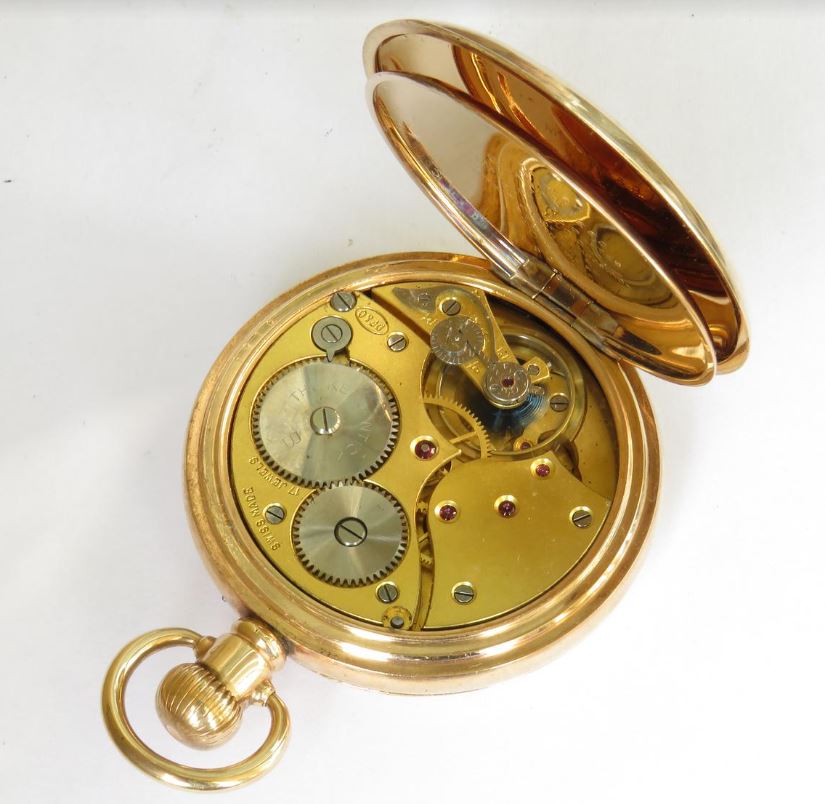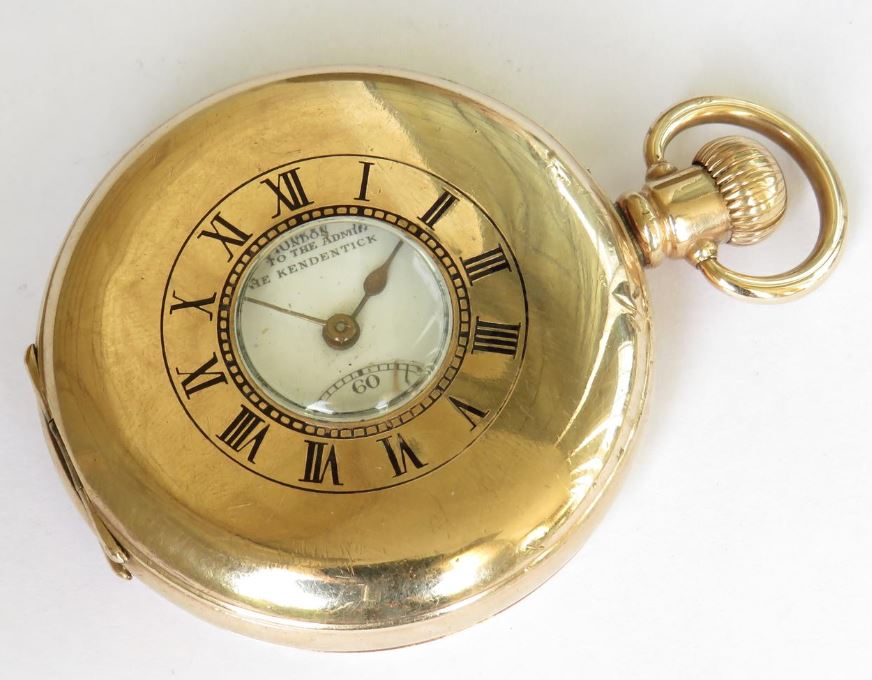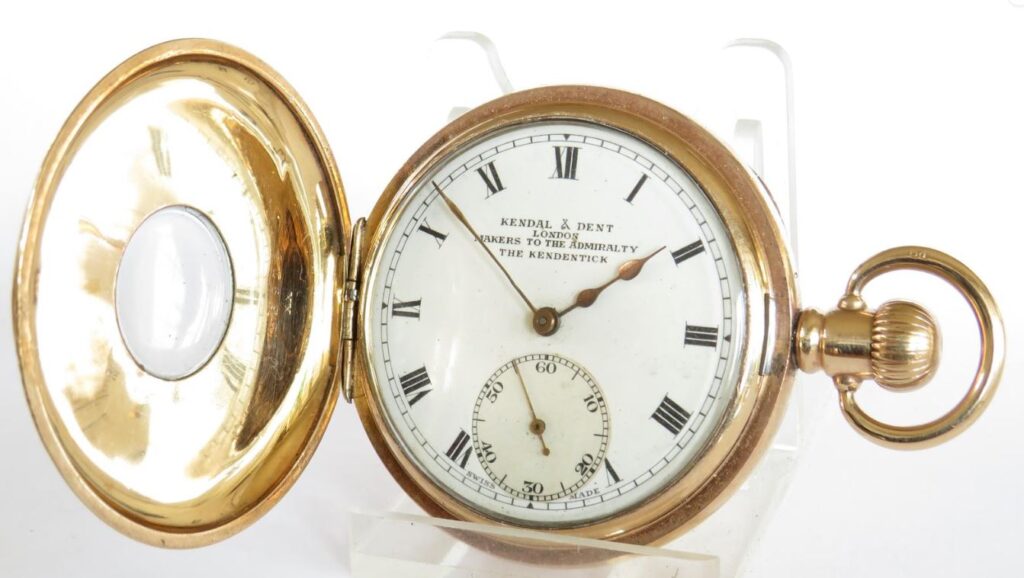Last updated on April 28, 2024
I recently came across this interesting pocket watch branded with the Kendal & Dent brand. I was familiar with the name and I thought there would be plenty to research about this for the Kendentick half hunter pocket watch. After all, the names involved with this watch were Revue, DF&C and Kendal & Dent. Below is what I discovered after days of research.
Movement
The watch has a Swiss made 17-jewel stem-winding movement which is keeping good time, to within two minutes a day. The movement is by Revue but signed DF&C for the Swiss exporting company Dimier Freres & Cie. It is also signed with the name The Kendentick, a brand name given to some of the watches retailed by Kendal & Dent. The movement is protected by an inner hinged cover which has a little marking where it has been opened in the past.
Dimier Freres & Cie
Dimier & Cie (Df&C) was founded by Jean Antoine Dimier (1795-1863) in Geneva in the early 19th century. DF&C specialised in making pocket watches for the Chinese market. A civil war broke out in China in 1860, effectively closing the market. At this time the company was being managed by Jean-Antoine Dimier’s two sons, Charles-Louis (1822-1896) and Auguste-Antoine (1824-1891). They moved away from watch manufacturing completely and became an exporter. Specifically, they exported Swiss made, Dimier branded watches and movements to England. In 1868 they opened a London office under the business name of Dimier Brothers & Company. In 1918 the company was under the direction of George and Amelia Dimier. The company finally closed in 1937.
Case
The watch measures 50mm in diameter excluding the winding stem and the loop. The case is the gold-filled Moon model from the English watch case maker The Dennison Watch Case Company. Dennison manufactured cases for various watchmakers, often as a way to bypass import tax on foreign cases with precious metal content.
The front of the case has a small central lens surrounded by enamel-filled Roman numerals. There is a slight unevenness to the front of the case and minor surface marking to the back. However, this wouldn’t be considered damage, rather it is consistent with normal use and would be considered patina. Overall, the case is in very acceptable condition for its age. The winding crown pushes in to open the front cover. Inside, there is an acrylic crystal which is in good condition.
The Dennison Watch Case Company
Aaron Lufkin Dennison (1812 – 1895) was an American-born businessman and a trained watchmaker. He had a long career in the watchmaking industry, but only found true success when he moved to England and founded the very successful Dennison Watch Case Company in Birmingham. Dennison died in 1895 and the business was taken over by his son, Franklin Dennison. The company continued as a successful business until 1967.
Dial
The enamel dial is signed with the name “Kendal & Dent, London, Makers to The Admiralty, The Kendentick”. The enamel dial is in good condition, although there is some slight discolouration to the subsidiary second’s dial. The original hands are gold-gilt, including the second hand. The hour hand has the typical half-hunter double spade shape that allows the time to be read when the cover is closed.
Kendal & Dent
As I mentioned in my opening, I was familiar with the name Kendal & Dent. I expected to find vast amounts of information online about their history. However, this was not the case. The three paragraphs below were about all I could find. These paragraphs were repeated across multiple websites and forums and little of the data referenced reliable sources.
Kendal & Dent was a partnership between James Francis Kendal and Edwin Dent. Between 1881-1941 they were based at 106 Cheapside and from 1942-1971 their address was Swan House 34-35 Queen Street, London EC4. The company was listed in various trade directories as a watchmaker. The listings added that they were also clockmakers, goldsmiths and jewellers. However, they always advertised themselves as watchmakers.
Kendal & Dent were sending chronometers for trial to Greenwich Observatory from 1881 to 1904, and it seems likely that their claim to be Makers to the Admiralty was valid (many such claims on watches are spurious). James Francis Kendal wrote a well-reputed book called “A history of watches and other timekeepers” in 1892.
Kendal & Dent was a well-reputed English maker, one of many who started making their own watches in the 19th century and moved on to import “private label” Swiss watches, such as this one, when the Swiss started to dominate the market in the 20th century.
My view
My view is slightly different to the above paragraphs. I don’t see any evidence that they were watchmakers. I think they were purely retailers of Swiss made, Kendal & Dent branded watches. The name Edwin Dent is also suspiciously similar to the highly prominent Dent Company which were responsible for making the famous Big Ben clock. Perhaps, this was some sort of marketing ploy. Alternatively, some other uncited sources list John Gilder Dent, as being the Dent side of the partnership. I can’t find any genealogical records for any of the Kendal & Dent entities.
I have no doubt that they submitted watches to the Greenwich chronometer trials. However, I question whether or not any were ever purchased by the Admiralty. Perhaps, there is a receipt lying in a dusty archive that might prove me wrong.
Advertising
There were a couple of Kendal & Dent articles in the Evanion catalogue at the British Library. A Kendal & Dent advertisement for an Inventions Exhibition had them listed as watch manufacturers and patentees. The list of patents, which weren’t numbered, included a watch for the blind, watches that showed 12-hour and 24-hour times on separate dials and a Mariner’s watch with an oxidised case. A separate article listed a numbered patent, 6577, for Kendal, J F and Goering, F for a dust-resistant case. They are not exactly groundbreaking inventions and are most likely a marketing ploy to legitimise Kendal & Dents as “watchmakers”. The advertisement also suggested that they had received “certificates” from the Kew Royal Observatory. Another advertisement from 1885 suggests they won a gold medal at the Paris Exhibition of 1885 for “improvements and general excellence in watches”.
Finally, I searched through completed auction lots for Kendal & Dent watches. The search was comprehensive, but by no means exhaustive. I am sure there are many sold lots that I missed. The earliest example of a Kendal & Dent watch dated to 1876, which was before they occupied their Cheapside address. The earliest example I saw that included “Makers to the Admiralty” on the dial was dated to 1889. Before this time the dial was either blank, stated Kendal & Dent, London. Later, watch dials were sometimes branded, Kendal & Dent Made at Buren. The Buren Watch Company in Switzerland was owned by the English manufacturer, H Williamson Ltd.
The final thing I noted, was that the watches were generally targeted at the lower to mid-level of the market. I’m guessing that Kendal & Dent provided robust, but reasonably priced timepieces. The last Kendal & Dent pocket watch from the sold lots, dated 1946. The company must have ended soon after.
Summary
I spent a lot of time researching Kendal & Dent. It was enjoyable, but very frustrating because so many of the references to Kendal & Dent were unsourced. A lot of guesswork went into the material above. In the end, despite the effort, I couldn’t bring myself to buy the Kendentick half-hunter pocket watch.
Related content
Kendal & Dent at The British Museum.



I came across a near identical Kendentick pocket watch in a house clearance. The watch winds, but needs a shake to get it working. It then seems to randomly stop before needing another shake to get it going again. Can this be easily fixed? Thanks in advance.
Hi Tony, the fact that it works at all is a good sign. It will just need a service. It could just be the case that the lubricants have dried out over the years. If you are in the UK there is a list of accredited repairers from the British Horological Institute. Other countries will have similar organisations. I hope this helps, Jason
Hi, I have a silver Kendentick pocket watch, that looks exactly like the photos. It dates from the 1920s and belonged to my grandfather. It doesn’t work. I can set the time, but when I wind the crown there is no pressure. Should I get it serviced? And by whom? Any advice is much appreciated, Helen
Hi Helen, from what you describe, the mainspring is probably broken. As a valuable family heirloom, I think you should get your Kendentick pocket watch repaired/serviced. It is much better to have a working antique watch that you can use on special occasions rather than a lump of metal that sits in a drawer. Read our post on antique watch servicing. Find a British accredited repairer near you and ask for a quote. It will be an investment for you and future heirs of your grandfather’s Kendentick pocket watch. I hope this helps, Jason.